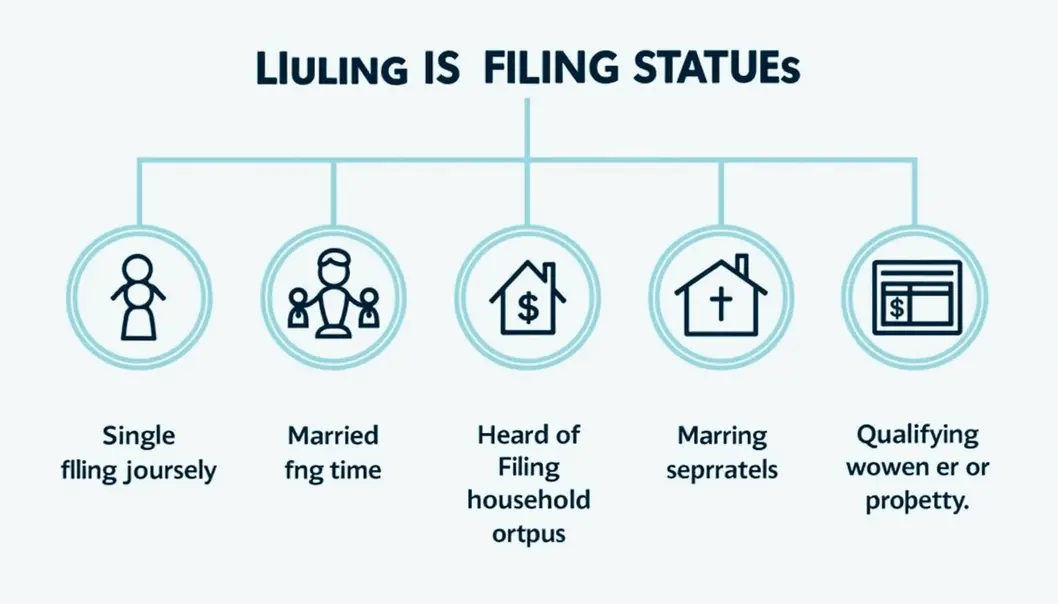Filing taxes for the first time can feel like navigating a maze with no map in hand. However, gaining a solid understanding of the process can transform this daunting task into a manageable one. Taxes are an essential civic duty, yet for many, the complexities of tax codes, forms, and deadlines can feel overwhelming. Understanding your filing status, gathering necessary documents, and knowing how to submit your return is key to filing efficiently. In this guide, we’ll explore the core elements needed to file your taxes successfully, starting with the critical aspect of understanding your filing status. This fundamental concept directly influences your tax rates, deductions, and credits, making it essential knowledge for every taxpayer. Armed with the right information and resources, you can navigate through your taxes confidently, ensuring you comply with regulations and maximize your eligible benefits.
Understanding Filing Status: The Foundation of Your Tax Return
Filing taxes can often appear to be a daunting process, especially for beginners. Yet, one of the simplest ways to demystify this annual chore is to understand filing status, a foundational aspect of your tax return. This seemingly straightforward concept plays a crucial role in determining your tax rates, eligibility for deductions and credits, and ultimately the amount of tax you owe or the refund you can expect.
Filing status essentially reflects your marital and family situation as of December 31 of the tax year. The Internal Revenue Service (IRS) recognizes five primary filing statuses, each with its own set of rules and implications:
-
Single: This status applies to individuals who are unmarried, legally separated, or divorced by the last day of the tax year. It is essential to note that a significant other or partnership does not qualify you for this status; it is solely based on legal marital status.
-
Married Filing Jointly: Married couples have the option to file a single joint return. This is often beneficial as it allows the couple to combine their incomes and deductions, typically reducing their tax liability due to lower tax rates and higher deduction limits.
-
Married Filing Separately: While some couples may choose to file separately, this option usually results in a higher tax burden and a loss of certain credits. However, it can be advantageous in specific situations, such as when one spouse has significant medical expenses or other deductible items.
-
Head of Household: Unmarried taxpayers who pay more than half the cost of maintaining a home for a qualifying dependent may file as Head of Household. This status offers better tax rates and a higher standard deduction compared to filing as Single.
-
Qualifying Widow(er) with Dependent Child: This status is available for widows or widowers who meet certain criteria, allowing them to use the more favorable joint return tax rates for up to two years after the death of their spouse.
Understanding which filing status is right for you is crucial, as it impacts several key aspects of your tax return. Your tax bracket and rates can vary significantly depending on your filing choice. Each status has different income thresholds, which determine how much tax you’ll ultimately owe.
Moreover, your filing status affects the standard deduction amounts. These deductions reduce your taxable income and can dramatically impact how much tax you owe. For example, a married couple filing jointly enjoys a higher standard deduction than two single filers, making it financially beneficial for many couples to file jointly.
Additionally, certain credits and deductions are uniquely tied to specific filing statuses. For instance, the Earned Income Tax Credit is only available to those qualifying for the appropriate status, often making it vital to select the correct one. This protocol helps you maximize your tax benefits and minimize your liabilities effectively.
To begin determining your filing status, reflect on your marital situation as of December 31. If you marry or divorce during the year, your status for that tax year is set based on your situation at year-end. This reality can be pivotal when you’re planning your tax preparation, as changes in marital status can lead to significant shifts in your tax obligations.
With the basics laid out, let’s dive deeper into the implications of each filing status:
Single filers often face higher tax rates on their income compared to those who file jointly. The increased rate is because married couples can spread their income over two people, often placing them in a lower tax bracket. This designation affects everything from withholding tax on paychecks to potential refunds.
Married Filing Jointly is the most common choice for couples. It allows for greater deductions and credits, which can include higher limits on contributions to retirement accounts and qualifications for various stimulative tax benefits. Tax breaks available to joint filers can significantly reduce taxable income, leading to a lower tax liability. However, couples must also consider the implications of both partners’ income and deductions, as these can affect the overall financial picture.
For couples who choose Married Filing Separately, the complexity increases. While it can sometimes save money, it also disqualifies filers from several deductions and credits, such as education credits and the aforementioned Earned Income Tax Credit. It’s critical to run the numbers in both scenarios—jointly and separately—to ensure you make the best choice for your individual situation.
In contrast, Head of Household filers enjoy lower tax rates and a consistently higher standard deduction than single filers. To qualify, individuals must support a dependent. This situation encourages households to be head-of-household, which can subsequently provide substantial tax relief.
Lastly, surviving spouses can benefit from the Qualifying Widow(er) status, which allows the deceased spouse’s income to be considered jointly. This status helps mitigate the financial impact of losing a loved one, especially when young children are involved. It’s crucial for recently widowed taxpayers to know this option exists as they plan their finances.
In summary, assessing your filing status is an essential step in preparing for tax season. It sets the stage for how much tax you owe, how many deductions you’ll be eligible for, and how to maximize your potential refund. By recognizing your marital and family status accurately as of the year-end and selecting the most advantageous filing option, you’re well on your way to small wins in your tax filing journey. To further enhance your understanding of taxes and their implications, consider exploring resources on understanding tax brackets.
Final thoughts
Understanding your filing status is just the beginning of mastering the tax filing process. With this knowledge and the right documentation, you can confidently prepare your taxes and maximize your potential benefits.
Continue your journey to smarter money decisions and tax filing by exploring more resources with us!
Learn more: https://savemawallet.com
About us
Join today to gain access to a wealth of financial resources, tips, and expert guidance that will empower you to make informed decisions about your money.


Leave a Reply
You must be logged in to post a comment.